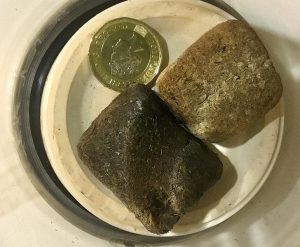How do wombats make cubed poo? That was what Patricia Yang and her fellow researchers at the Georgia Institute of Technology wanted to know. Their research, which was first presented at the 71st Annual Meeting of the APS Division of Fluid Dynamics and which has since gone on to win an Ig Nobel Prize earlier this month, sheds light on the processes involved in the creation of the distinctively shaped feces.

Wombat – Wikipedia Commons
Why Cubes and Why Is It Interesting?
In the modern world, most cubes or rectangular prisms are formed by one of two methods, extrusion and/or injection molding.
Extrusion is the same process that occurs when you squeeze a tube of toothpaste out, producing a long cylindrical piece. In essence, extrusion involves pushing a material through a die shaped like the cross-section of the final product (in the case of a cube, the cross-section would be a square). The resulting extrudate (the material that has been extruded) is then cut to size.
Injection molding is takes a material in a heated and liquid state, and injecting it into a mold. As the material cools, it takes on the shape of the mold cavity. The mold is then separated and the resulting injection molded piece is then cleaned.
Cubes are a shape rarely found in nature and therefore, the wombat’s cubic scat has always been a fascinating mystery.

Lego, Injection Molded Plastic Toy Bricks – Semevent, Pixabay with Editorial License
As it turns out, wombats use piles of their poop to mark territory, much like how dogs use urine to do the same. Like their plastic brick counterparts, cubed poos are simply better at stacking than conventionally shaped fecal matter.

Wombat Excrement, Showing Distinctive Cube Shape – Wikipedia Commons
So How Do Wombats Make Cubed Poo?
When Dr. Yang and her fellow researchers were given two corpses of wombats euthanized after vehicle accidents, they began to dissect them immediately. The researchers began by inflating a long balloon into the animal’s intestines. They measured the elasticity of the intestinal walls and found that the elasticity varied at different points of the wall. The researchers theorize that the stretchier sections were responsible for the curved corners where as the more rigid sections were responsible for the straight and flat edges of the poop. They also found that only the last 8% of the intestines were actually responsible for the shaping of the excrement. Some also think that wombat diet has much to do with the formation and stability of the cube shape. The dryness of wombat diet helps maintain the rigid shape.
Why Is This Important To Us?
As mentioned previously, we normally use extrusion or injection molding to form cubic shapes. The revelation that we can use soft elastic tissue to form cuboids may provide new techniques for manufacturing.
